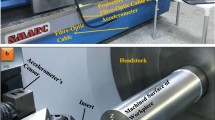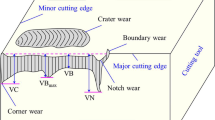Abstract
Liquid nitrogen (LN2) machining is considered as a safe, clean, and environmentally friendly machining process. This paper aims to investigate the vibration, tool wear and surface roughness mechanism of the ceramic insert during turning of Inconel 718 alloy under dry machining and LN2 machining. The experiments were performed at three cutting speeds (100, 150, 200 m/min), feed rates (0.04, 0.08, 0.12 mm/rev) and depths of cut (0.2, 0.4, 0.6 mm). The experiment results show better machinability and longer tool life in LN2 machining. The vibration acceleration is reduced by 14–32%. A 17–34% reduction of workpiece surface roughness is observed. Flank wear and notch are the predominant wear forms both in LN2 machining and dry machining, and 16–34% reduction of flank wear is noted in LN2 machining.











Similar content being viewed by others
References
Jafarian F, Umbrello D, Golpayegani S, Darake Z (2016) Experimental investigation to optimize tool life and surface roughness in Inconel 718 machining. Mater Manuf Process 31(13):1683–1691
Chetan Ghosh S, Rao PV (2016) Environment friendly machining of Ni–Cr–Co based super alloy using different sustainable techniques. Mater Manuf Process 31(7):852–859
Zhu D, Zhang X, Ding H (2013) Tool wear characteristics in machining of nickel-based super alloys. Int J Mach Tools Manuf 64:60–77
Paul S, Dhar NR, Chattopadhyay AB (2001) Beneficial effects of cryogenic cooling over dry and wet machining on tool wear and surface finish in turning AISI 1060 steel. J Mater Process Tech 116(1):44–48
Dhar NR, Paul S, Chattopadhyay AB (2002) Machining of AISI 4140 steel under cryogenic cooling–tool wear, surface roughness and dimensional deviation. J Mater Process Tech 123(3):483–489
Hong SY (2006) Lubrication mechanisms of LN2 in ecological cryogenic machining. Mach Sci Technol 10(1):133–155
Hong SY, Ding Y (2001) Cooling approaches and cutting temperatures in cryogenic machining of Ti-6Al-4V. Int J Mach Tools Manuf 41(10):1417–1437
Kaynak Y (2014) Evaluation of machining performance in cryogenic machining of Inconel 718 and comparison with dry and MQL machining. Int J Adv Manuf Tech 72(5–8):919–933
Venugopal KA, Paul S, Chattopadhyay AB (2007) Tool wear in cryogenic turning of Ti-6Al-4V alloy. Cryogenics 47(1):12–18
Dhananchezian M, Kumar MP, Sornakumar T (2011) Cryogenic turning of AISI 304 stainless steel with modified tungsten carbide tool inserts. Mater Manuf Process 26(5):781–785
Dhar NR, Kamruzzaman M (2007) Cutting temperature, tool wear, surface roughness and dimensional deviation in turning AISI-4037 steel under cryogenic condition. Int J Mach Tools Manuf 47(5):754–759
Al-Zaharnah IT (2006) Suppressing vibrations of machining processes in both feed and radial directions using an optimal control strategy: the case of interrupted cutting. J Mater Process Technol 172(2):305–310
Thomas M, Beauchamp Y (2003) Statistical investigation of modal parameters of cutting tools in dry turning. Int J Mach Tools Manuf 43(11):1093–1106
Devillez A, Dudzinski D (2007) Tool vibration detection with eddy current sensors in machining process and computation of stability lobes using fuzzy classifiers. Mech Syst Signal Process 21:441–456
Hessainia Z, Belbah A, Yallese MA, Mabrouki T, Rigal JF (2013) On the prediction of surface roughness in the hard turning based on cutting parameters and tool vibrations. Measurement 46(5):1671–1681
Abouelatta OB, Mádl J (2001) Surface roughness prediction based on cutting parameters and tool vibrations in turning operations. J Mater Process Technol 118:269–277
Richards N, Aspinwall D (1989) Use of ceramic tools for machining nickel based alloys. Int J Mach Tools Manuf 29:575–588
Kono Y, Hara A, Yazu S, Uchida T, Mori Y (1980) Cutting performance of sintered CBN tools. In: Proceedings of international conference on cutting tool materials. Fort Mitchell, KY, pp 281–95
Ezugwu EO, Pashby IR (1992) High speed milling of nickel-based superalloys. J Mater Process Technol 3:429–437
Ezugwu EO, Tang SH (1995) Surface abuse when machining cast iron (G-17) and nickel-base superalloy (Inconel 718) with ceramic tools. J Mater Process Technol 55:63–69
Narutaki N, Yamane Y, Hayashi K, Kitagawa T (1993) High speed machining of Inconel 718 with ceramic tools. Ann CIRP 42(1):103–106
Altin A, Nalbant M, Taskesen A (2007) The effects of cutting speed on tool wear and tool life when machining Inconel 718 with ceramic tools. Mater Des 28:2518–2522
Wanga Qiang, Wub Yongbo, Guc Jia, Lud Dong, Jie Yuebo, Nomurab Mitsuyoshi (2016) Fundamental machining characteristics of the in-base-plane ultrasonic elliptical vibration assisted turning of Inconel 718. Procedia CIRP 42:858–862
Akıncıoğlu Sıtkı, Gökkaya Hasan, Uygur İlyas (2016) The effects of cryogenic-treated carbide tools on tool wear and surface roughness of turning of Hastelloy C22 based on Taguchi method. Int J Adv Manuf Technol 82(1–4):303–314
Yıldırım Çagrı Vakkas, Kıvak Turgay, Erzincanlı Fehmi (2014) Tool wear and surface roughness analysis in milling with ceramic tools of Waspaloy: a comparison of machining performance with different cooling methods. J Braz Soc Mech Sci Eng 41(2):83
VakkasYıldırım Çağrı, Kıvak Turgay, Sarıkaya Murat, Şirin Şenol (2020) Evaluation of tool wear, surface roughness/topography and chip morphology when machining of Ni-based alloy 625 under MQL, cryogenic cooling and CryoMQL. J Mater Res Technol 9(2):2079–2092
Sivaiah P, Chakradhar D (2017) Influence of cryogenic coolant on turning performance characteristics: a comparison with wet machining. Mater Manuf Process 32(13):1475–1485
Carou D, Rubio EM, Lauro CH, Davim JP (2016) The effect of minimum quantity lubrication in the intermittent turning of magnesium based on vibration signals. Measurement 94:338–343
Sofuoglu Mehmet Alper, Orak Sezan (2015) A hybrid decision making approach to prevent chatter vibrations. Appl Soft Comput 37:180–195
Prasad BS, Babu MP (2017) Correlation between vibration amplitude and tool wear in turning: numerical and experimental analysis. Eng Sci Technol Int J 20(1):197–211
He CL, Zong WJ, Zhang JJ (2018) Influencing factors and theoretical modeling methods of surface roughness in turning process: state-of-the-art. Int J Mach Tools Manuf 129:15–26
Altin Abdullah (2014) Optimization of the turning parameters for the cutting forces in the hastelloy X Superalloy based on the Taguchi method. Mater Technol 48(2):249
Hessainia Z, Belbah A, Yallese MA, Mabrouki T, Rigal JF (2013) On the prediction of surface roughness in the hard turning based on cutting parameters and tool vibration. Measurement 46:1671–1681
Hong SY, Ding Y, Jeong WC (2001) Friction and cutting forces in cryogenic machining of Ti-6Al-4 V. Int J Mach Tools Manuf 41(15):2271–2285
Özbek NA, Çiçek A, Gülesin M, Özbek O (2016) Effect of cutting conditions on wear performance of cryogenically treated tungsten carbide inserts in dry turning of stainless steel. Tribol Int 94:223–233
Musfirah AH, Ghani JA, Che Haron CH (2017) Tool wear and surface integrity of Inconel 718 in dry and cryogenic coolant at high cutting speed. Wear 376–377:125–133
VakkasYıldırım Çağrı (2020) Investigation of hard turning performance of eco-friendly cooling strategies: cryogenic cooling and nanofluid based MQL. Tribol Int 144:106127
Ravi S, Kumar MP (2011) Experimental investigations on cryogenic cooling by liquid nitrogen in the end milling of hardened steel. Cryogenics 51(9):509–515
Gill SS, Singh H, Singh R, Singh J (2011) Flank wear and machining performance of cryogenically treated tungsten carbide inserts. Mater Manuf Process 26(11):1430–1441
Mozammel Mia Md, Khan Awal, Dhar Nikhil Ranjan (2017) Study of surface roughness and cutting forces using ANN, RSM, and ANOVA in turning of Ti-6Al-4V under cryogenic jets applied at flank and rake faces of coated WC tool. Int J Adv Manuf Technol 93:975–991
Ghani JA, Choudhury IA, Masjuki HH (2004) Performance of P10 TiN coated carbide tools when end milling AISI H13 tool steel high cutting speed. J Mater Process Technol 153:1062–1066
Akhtar W, Sun J, Chen W (2016) Effect of machining parameters on surface integrity in high speed milling of super alloy GH4169/Inconel 718. Mater Manuf Process 31(5):620–627
Zhuang k, Zhu D, Zhang X, Ding H (2014) Notch wear prediction model in turning of Inconel 718 with ceramic tools considering the influence of work hardened layer. Wear 313(1–2):63–74
Acknowledgments
This work is supported by the Special Fund of High-end CNC Machine Tools and Basic Manufacturing Equipment (2017ZX04002001), China.
Author information
Authors and Affiliations
Corresponding author
Additional information
Technical Editor: Adriano Fagali de Souza.
Publisher's Note
Springer Nature remains neutral with regard to jurisdictional claims in published maps and institutional affiliations.
Rights and permissions
About this article
Cite this article
Mou, W., Zhu, S. Vibration, tool wear and surface roughness characteristics in turning of Inconel 718 alloy with ceramic insert under LN2 machining. J Braz. Soc. Mech. Sci. Eng. 42, 369 (2020). https://doi.org/10.1007/s40430-020-02438-8
Received:
Accepted:
Published:
DOI: https://doi.org/10.1007/s40430-020-02438-8




